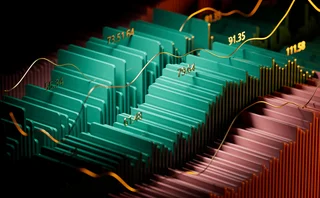European exchanges turn to dark trading in battle for flow
The EU’s two biggest exchanges are launching dark pools this year. The apparent change in their stances on dark trading reflects a profound shift in equities markets.

“Once is coincidence. Twice is happenstance. Three times is enemy action.” When James Bond comes face-to-face with supervillain Auric Goldfinger for the third time—captured by bodyguards in the grounds of his workshop near Lake Geneva—the gold baron greets him with these ominous words.
If Goldfinger watched equities markets as closely as spot commodities, he would probably say that the proliferation of dark pools run by European stock exchanges is more than just coincidence, too.
Dark pools—where financial institutions can trade against counterparties without first displaying their order, by matching orders at reference prices derived from lit markets—were once the preserve of multilateral trading facilities (MTFs), which are regulated differently from national exchanges. And even when European stock exchanges began buying up or opening their own dark pools, they were still operated as MTFs. This was the case for Nasdaq’s launch of Neuro Dark and the London Stock Exchange’s acquisition of Turquoise, both in 2009.
Fifteen years later, Euronext and Deutsche Börse are entering the dark pool game. Euronext made Belgian shares available for dark trading this week, with plans to extend the functionality to its other six markets in April. And, as first reported by WatersTechnology last week, Deutsche Börse is in the process of building its own dark book, with a launch anticipated for November.
Both exchanges have previously called for constraints on dark trading.
The philosophical U-turn from them, I think, is quite interesting. They have sought to cap and eliminate dark pools since Mifid in 2007. And now they’re launching one
European exchange executive
In a memo from 2020, Euronext said that trading venues like dark pools that consume reference prices rather than helping to form them accounted for more than half of overall European volumes. The exchange encouraged policymakers to remove the Reference Price Waiver, the regulatory carveout exempting members of dark pools from the need to disclose their quote to the market before an order is executed. If the EU acted on Euronext’s suggestion, “the practice of allowing venues to piggyback on price formation enabled by transparent venues would be curtailed,” the memo said.
And in its 2020 response to the European Commission’s consultation on priorities for the review of the second Markets in Financial Instruments Directive (Mifid II), Deutsche Börse also called for a “simplified equity market structure,” including the reduction of transparency waivers.
A source familiar with Deutsche Börse’s plans says the German exchange, which previously closed its dark pool business in 2017, began its dark pool initiative based on discussions with clients starting in March last year. Trading members were asking for a midpoint offering integrated in the reference market, a setup that could help to close a latency loophole making it more expensive for institutional brokers to trade on other dark pools.
Speaking before WatersTechnology broke the news of Deutsche Börse’s dark pool project, an executive at a competing European exchange said that Euronext’s move was a bid to keep in step with a market that increasingly relies on dark trading as a means of managing liquidity risk and securing better prices.
“The philosophical U-turn from them, I think, is quite interesting. They have sought to cap and eliminate dark pools since Mifid in 2007. And now they’re launching one,” they said. “I think that’s a tacit or an active admission that you have to compete to bring flow into the exchange environment, and that having more innovative and varied exchange services is an effective way of doing that. That’s actually quite a big change.”
Flash Boys 2.0?
This time, crucially, the dark pools will be integrated with the primary markets that run them. Euronext and Deutsche Börse say this setup will allow them to close a latency loophole that exposes users of MTF-run dark venues to the predations of high-frequency traders (HFTs).
Euronext migrated its datacenter from the UK to Italy in June 2022, following its acquisition of Borsa Italiana. The amount of time taken for electronic messages to travel from London to Euronext’s matching engine subsequently increased by roughly a factor of 20.
London-based MTFs offering Euronext securities in the dark derive their prices from the midpoint of bid-offer spreads on Euronext’s lit markets, now hosted in Italy. Research by Euronext finds that almost a third of dark trade prices on MTFs are stale, giving market participants with faster datafeeds the opportunity to see and benefit from the favorable prices.
We are seeing a sort of Flash Boys 2.0 in Europe. This time, it’s not with fiber; it’s through microwave
Vincent Boquillon, Euronext
In practice, the fastest known messaging networks widely used by market participants are microwave towers—although firms are trialing other technologies, including shortwave radio frequencies. Market participants who co-locate near the matching engine and have access to private microwave networks can reduce the latency that institutional brokers, with fiber-optic connections to infrastructure in London, have to contend with.
“We are seeing a sort of Flash Boys 2.0 in Europe. This time, it’s not with fiber; it’s through microwave. So instead of having a direct physical link, you build towers 30 kilometers away from each other, all around Europe. And this allows you to be twice as fast as fiber,” says Vincent Boquillon, head of cash equities at Euronext.
Euronext says that more than 80% of trades executed against stale prices on dark MTFs take place less than 5 milliseconds after the reference price on the lit venue changed. In other words, it seems that while the new midpoint price is on its way from Bergamo to London, HFTs with private microwave networks are able to identify the mismatch in prices on the two venues and trade against the passive orders of slower market participants at the MTF who are not aware that the price in Bergamo has moved.
Research conducted using the Financial Conduct Authority’s (FCA’s) proprietary transaction-level data corroborates this, finding that around 95% of stale trades benefit proprietary traders. According to Euronext, the average “latency tax” of any trade on a dark MTF is 0.7 basis points.
And if a firm sends the unfilled portion of a dark order onward to Euronext’s lit venue in Italy, that 8-millisecond lag to receive fresh prices becomes a 16-millisecond round trip, giving HFTs the opportunity to front-run their lit orders based on the dark print.
By running a dark pool in the same datacenter as the lit venue, Euronext says it can immediately import prices from the source, removing the risk of stale trades on the dark venue. It can also offer sweep trades, pushing any unfilled volume from the dark book onto the lit book almost instantaneously.
“After our move of datacenter, a large number of sell siders and even props came to us and suggested [to] launch a dark pool on Euronext because there is a latency issue in between London and Bergamo—something that they never told us for the last decade or so,” Boquillon says.
The source familiar with Deutsche Börse’s dark pool project says similar considerations underpinned the German exchange’s move. With a datacenter based in Frankfurt, Deutsche Börse also identified an opportunity to reduce the scope for HFTs to benefit from stale prices by building a dark pool next to the matching engine for the reference market.
“The two settings will be very similar in many aspects. I’ve seen the presentation from Euronext where they describe all the reasoning, with the latency arbitrage and the dislocation between the price source and the locations of any third-party venues. … It’s the same reasoning, absolutely,” the source says.
But a quantitative finance expert at a trading firm specializing in statistical arbitrage strategies says that even the nanoseconds taken to transfer the reference price from the main matching engine to a dark book in the same location can provide scope for arbitrage.
“The HFTs will always be one step ahead, so arbitrage will still be possible. For example, we are researching into minimizing latency even further with the use of quantum networks, where zero—or close to zero—becomes a possibility, and entering a trade before the price makes any noticeable move allows for arbitrage,” they say.
If you can’t beat them …
Liquidity in Europe has been fragmenting across venues and markets since the implementation of Mifid II in 2018. According to Liquidnet’s February 2024 “Liquidity Landscape” report, the share of overall trading volume on primary lit venues excluding auctions was near record lows in Q4 2023, at just 34%.
After the proportion of shares traded on unlit venues surged from 1% to 8% in just seven years, lawmakers attempted to limit trading with Mifid II. The new regime capped the proportion of trading that could take place in the dark for individual stocks, both on any given venue and in aggregate across the market.
In the Mifid II review, passed by the European Parliament in January, the EU agreed to replace this “double volume cap” with a single, 7% cap on the proportion of an individual share’s overall volumes that can be traded in the dark.
But seemingly due to an oversight by legislators, no provision has been made for the window between the double volume cap being phased out (due in April) and the new single cap being introduced (likely late 2025). Unless lawmakers are able to agree on further legislation in that time, there will be no cap on the proportion of shares that can be traded in the dark for 18 months.
Sources say the EU can likely come up with a quick fix for this apparent fumble, but it has drawn attention to the direction of travel: limitations on dark trading appear to be getting less restrictive.
I think the dark caps are destined for demise because I don’t believe anyone thinks they work well, but only add unnecessary complexity
Mark Schaedel, DataBP
Mark Schaedel, CEO of licensing and subscription management services provider DataBP, says the cap mechanism in Europe has so far failed to effectively limit dark trading. “I think the dark caps are destined for demise because I don’t believe anyone thinks they work well, but only add unnecessary complexity. These rigid conduct rules rarely prove effective and if based on some percentage, they will always be somewhat arbitrary and pose a problem for broad application,” he says.
Schaedel points out that the dark caps are policed by national competent authorities (NCAs), rather than by the European Securities and Markets Authority (Esma). In practice, this allows firms to do most of their dark trading in jurisdictions with the least NCA oversight.
Meanwhile, exchanges are facing growing demand for dark trading functionalities to manage liquidity risk and secure improved prices, and the regulatory environment appears to permit this option. So, Schaedel asks, why would they not offer dark books?
“For public order books to be sustainable, there needs to be a commercial model incentive for me to trade on them. If not, internalization and dark trading will always win because there is a commercial incentive for the execution providers,” he says.
Technical difficulties
SIX Swiss Exchange has a unique understanding of the drivers and complexities of setting up a dark trading functionality integrated with a lit book. It launched SwissAtMid in 2016, and the dark pool now commands close to 50% of dark market share in Swiss securities.
Like the Euronext and Deutsche Börse dark books, SwissAtMid is run on the same matching cycle as the lit order book for the national exchange, which provides the reference price.
Simon McQuoid-Mason, SIX’s head of equity products for the UK and Ireland, says that the ability to eliminate stale prices is not the only advantage of integrating a dark and lit order book—it also means that you can introduce inter-book order types without risk of overfill. As well as sweep orders, which come with less opportunity cost when there is no latency between the dark print and the unfilled portion of the order appearing on the lit book, SwissAtMid also offers order types that allow a firm to dually represent their order on the dark and lit books simultaneously.
“There are a kaleidoscope of different trading objectives. And often, many of those objectives don’t fit particularly well with being traded in size on a visible central limit order book. So we would absolutely welcome other European primary exchanges following our lead and recognizing the validity of other execution mechanisms,” says McQuoid-Mason.
But he adds that it is important to introduce dark trading functionalities in a way that makes it as easy as possible for trading members to adopt the solution, without adding complexity to their workflows. Another consideration of introducing an integrated dark book is the potential knock-on impact on liquidity.
“By definition, it’s great for participants because it gives them the chance to price improve. But the quid pro quo is that if they are able to find midpoint liquidity with regular success, then potentially it dampens down aggressive order arrival rates on the central limit order book a little bit,” McQuoid-Mason says.
But Euronext’s Boquillon believes that the launch of the dark book will not affect the lit book. On the contrary, he says, due to the latency consideration, more trading members doing sweep trades will choose to route their orders to the dark pool hosted alongside the lit book. “By offering that on Euronext, we will attract flow that would otherwise go to our competitors,” he says.
He also cites Euronext’s network of brokers across seven geographies, some of whom he says do not currently operate in the dark, but who could be persuaded by the opening of a Euronext dark pool.
But the executive at a competing exchange says that they doubt Euronext will be able to persuade participants to trade in the dark if MTFs and other exchanges have failed. “The brokers are the ones who are experts at measuring markouts. They’ll measure it, they’ll decide,” the executive says.
But with Europe’s five biggest exchanges by market cap now either running dark pools or preparing to do so, it is clear that dark venues are on the rise. And Euronext’s Boquillon says that the proportion of European equities trading taking place in the dark is on a similar trajectory. “At a bare minimum, we expect it to plateau or increase,” he says.
All eyes will now be on the Euronext and Deutsche Börse dark pool launches. Their ability to attract flow to their dark books without reducing liquidity on their lit books or slowing down lit orders will set the tone for other exchanges mulling more dark functionalities.
“The proof will be in the pudding,” says the executive at a competing European exchange. “If customers adopt the service, that means they designed it well, they priced it well, they sold it well. And if they get very little adoption, it’s because they fell down.”
Further reading
Only users who have a paid subscription or are part of a corporate subscription are able to print or copy content.
To access these options, along with all other subscription benefits, please contact info@waterstechnology.com or view our subscription options here: http://subscriptions.waterstechnology.com/subscribe
You are currently unable to print this content. Please contact info@waterstechnology.com to find out more.
You are currently unable to copy this content. Please contact info@waterstechnology.com to find out more.
Copyright Infopro Digital Limited. All rights reserved.
As outlined in our terms and conditions, https://www.infopro-digital.com/terms-and-conditions/subscriptions/ (point 2.4), printing is limited to a single copy.
If you would like to purchase additional rights please email info@waterstechnology.com
Copyright Infopro Digital Limited. All rights reserved.
You may share this content using our article tools. As outlined in our terms and conditions, https://www.infopro-digital.com/terms-and-conditions/subscriptions/ (clause 2.4), an Authorised User may only make one copy of the materials for their own personal use. You must also comply with the restrictions in clause 2.5.
If you would like to purchase additional rights please email info@waterstechnology.com
More on Trading Tech
Recent volatility highlights tech’s vital role in fixed income pricing
MarketAxess’ Julien Alexandre discusses how cutting-edge technology is transforming pricing and execution in the fixed income market amid periodic bouts of volatility
Banks fret over vendor contracts as Dora deadline looms
Thousands of vendor contracts will need repapering to comply with EU’s new digital resilience rules
Where have all the exchange platform providers gone?
The IMD Wrap: Running an exchange is a profitable business. The margins on market data sales alone can be staggering. And since every exchange needs a reliable and efficient exchange technology stack, Max asks why more vendors aren’t diving into this space.
This Week: Trading Technologies completes ANS deal; State Street; Equinix; and more
A summary of the latest financial technology news.
Interactive Brokers looks beyond US borders for growth opportunities
As retail trading has grown in volume and importance, Interactive Brokers and others are expanding international offerings and marketing abroad.
JP Morgan’s goal of STP in loans materializes on Versana’s platform
The accomplishment highlights the budding digitization of private credit, though it’s still a long road ahead.
As data volumes explode, expect more outages
Waters Wrap: At least for those unprepared—though preparation is no easy task—says Anthony.
This Week: ICE Bonds and MarketAxess plan to connect liquidity networks, TS Imagine, Bloomberg, and more
A summary of the latest financial technology news.








